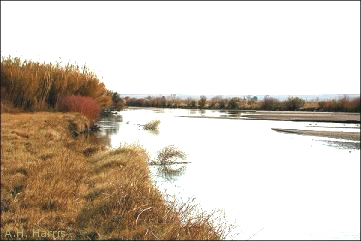

At one time, the Rio Grande meandered back and forth across the flat floor of the valley, the floodplain. Looping bends of the river were often cut off, leaving pools of water filling the resultant oxbows. The annual surge in waters from melting snows in Colorado and northern New Mexico often overflowed the low, natural levees bordering the river and inundated the valley bottom, leaving behind new layers of rejuvenating silt. The valley-floor vegetation included extensive bosques of cottonwoods and willows, while the wetlands supported a wide variety of fish, turtles, and aquatic birds.
Later, in the interests of stability and water conservation, the Rio
Grande in southern New Mexico and adjacent Texas has been straightened and confined
between artificial levees, while dams upstream prevent wide-scale flooding. The valley
bottom supports irrigated cropland and suburban developments, but little in the way of
past glories. Civilization apparently is inevitable, but we have paid a steep price. As
we rethink what is important in life, surely we can do a better job than in the
past.

Contributor: Arthur H. Harris, Laboratory for Environmental Biology, Centennial Museum, University of Texas at El Paso.
Desert Diary is a joint production of the Centennial Museum and KTEP National Public Radio at the University of Texas at El Paso.

The Rio Grande today, tamed and confined. Photograph by A. H. Harris